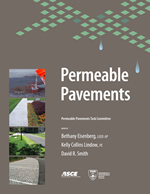 |
| The publication is available from ASCE, www.asce.org/publications, in soft cover (Stock No. 41378) or e-book (pdf) (Stock No. 47867). |
The Interlocking Concrete Pavement Institute (ICPI) teamed with the American Society of Civil Engineers (ASCE) and its Environmental & Water Resources Institute (EWRI) for the first book on design, construction and maintenance of permeable interlocking concrete pavement, pervious concrete and porous asphalt.
ICPI made a significant contribution to ASCE’s 260-page Permeable Pavements. With 30 other contributors, ICPI’s Technical Director David R. Smith provided chapters on permeable interlocking concrete paver and grid pavements. He also co-edited the entire publication with co-editors/authors and the ASCE/EWRI Permeable Pavement Task Committee co-chairs: Bethany Eisenberg, LEED AP, A.M. ASCE, director of Stormwater Services at Vanasse Hangen Brustlin Inc. in Watertown, Mass.; and, Kelly Lindow, P.E., A.M.ASCE, principal of CityScape Engineering LLC in Baltimore. The book’s co-editors and contributors are also members of the Low Impact Development Committee of the Urban Water Resources Research Council within EWRI.
Permeable Pavements addresses this cornerstone tool for low-impact development and sustainable design: pavements that confine runoff volume, increase groundwater recharge and improve water quality. ASCE/EWRI Permeable Pavements Task Committee members present the book as an essential reference for civil engineers, federal, state and municipal road and stormwater regulatory agencies, urban planners, landscape architects, and property owners planning to implement permeable pavements, an Environmental Protection Agency-recognized best management practice for stormwater control and improved site design.
The publication synthesizes today’s knowledge of the technology, drawing from academia, industry, and the engineering and science communities. Detailed design, construction, use, and performance information are provided for pervious concrete, permeable interlocking concrete pavements, porous asphalt and grid pavements. Fact sheets summarizing each technology with comprehensive design, construction and maintenance checklists help users incorporate permeable pavement systems into projects. Additional chapters summarize emerging technologies, maintenance considerations, hydrologic design approaches, and key components for specification writing.
